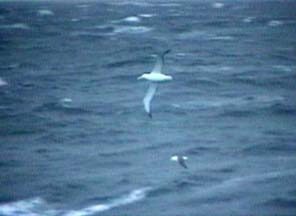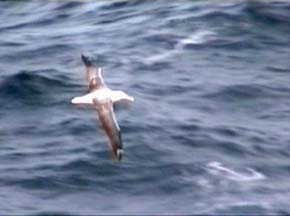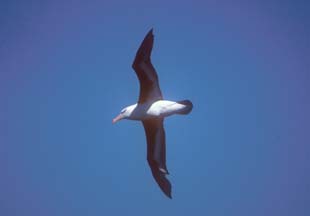
(Click on any image below for a larger version)
Thursday, January 18
The eastern sky began to brighten before 5:00 in the morning. The ship was still cruising through the Beagle Channel and a slight swell was rolling it gently from side to side. The mountains of the southern coast of Tierra del Fuego rose abruptly from the edge of the channel.
Numerous seabirds were flying over the water of the channel. Southern Giant Petrels and Black Browed Albatrosses were the most common.
 A Wandering Albatross was flying among the
Black Browed Albatrosses. The Wandering Albatross was noticeably
larger than the Black Browed Albatrosses.
A Wandering Albatross was flying among the
Black Browed Albatrosses. The Wandering Albatross was noticeably
larger than the Black Browed Albatrosses.
The breakfast buffet opened at 7:00 in the Columbus Lounge. The serving staff had laid out a bountiful spread of fruits, cereals, eggs, and a variety of fish. There was plenty of lox with horseradish mixed in whipped cream. There was a big bowl of mustard and dill spiced herring.
We spent the day cruising across from Tierra del Fuego to the Falkland Islands. Since there were no landings on this first day at sea, a series of lectures was presented in the auditorium on the lowest deck. The darkened room and the rocking of the ship put many of the people in the lecture to sleep and made several of the others seasick.
The first lecture of the trip was about the seabirds of the southern oceans. It was presented by Sylvia Stevens, a Scottish biologist, and was accompanied by her slides of the various birds that we could expect to see on the voyage.
Sylvia Steven's photographs are marketed through AGPix
Following Sylvia’s lecture there was a short break before the next briefing. I took my video camera to the aft deck. Isla del los Estedos, the most southeastern part of Chile, was just disappearing over the horizon. Sylvia was explaining how to tell apart the various pelagic sea birds that were flying around the stern of the ship. Within minutes I had video footage of
 a
Wandering Albatross (the largest of the Albatrosses),
a
Wandering Albatross (the largest of the Albatrosses),
 Black
Browed Albatrosses, and a Cape Petrel. We would see large numbers
of all of these birds during the cruise.
Black
Browed Albatrosses, and a Cape Petrel. We would see large numbers
of all of these birds during the cruise.
Geoff Green, the ship's tour leader presented a briefing about rules of the International Association of Antarctic Tour Operators regarding visits to Antarctica. While in Antarctica we were not to leave or remove anything at all. The one exception was that we should pick up any recent trash that we might find. Old litter had historic significance and was to be left in place. We were not allowed to take samples of feathers, eggshells, or even pebbles from the beach. We were instructed to take only pictures and leave only footprints.
Link to Geoff Green's biography.
Link to the International Association of Antarctic Tour Operators.
They are only allowed to land 100 people at a time at any one location, so the passengers were divided into two groups. The groups would alternate landing first at each location. After the first group had their time ashore and started to return to the ship, the second group would be brought ashore.
Following lunch, wellingtons and parkas were provided to the cruise passengers in the Explorer lounge. Wellingtons, also called wellies, are calf-high, rubber boots to keep our feet dry during Zodiac landings.
The third lecture of the day was presented by Joann Stock, a professor of geology at Caltech. She explained how current tectonic theory suggests that the Falkland Islands used to be located to the southeast of the continent of Africa. The piece of plate that they are part of has possibly moved around the bottom of Africa toward South America, and the islands seem to have rotated 180 degrees in the process.
Link to Joann Stock's page at Caltech
David Fletcher wrapped up the lectures of the day with an introduction to the history of the Falklands. David was formerly a British Antarctic Expedition base commander and has a great enthusiasm for the history of the region.
The end of the first day at sea was commemorated by a cocktail party in the Explorer Lounge, followed by the Captain's welcome dinner in the Marco Polo Restaurant. The ship's photographer took pictures of the passengers with Captain Notke as they entered the dining room.
 Table of Contents
Table of Contents  Send
a message to Brian.
Send
a message to Brian.